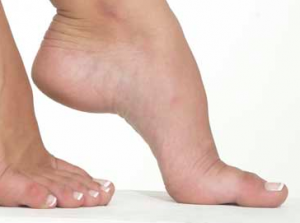 A
foot with high arches is often referred to as a pes cavus foot, and usually displays supination during
gait, meaning it tends to roll outwards. This can place strain on the heel, ball of the foot and the outside (lateral) foot border.
It can also impair the stability of the foot, and increase the chance of spraining your ankle. It should be noted that having a high
arched foot doesn’t mean you are definitely going to develop foot pain or issues, but it does increase your likelihood of developing
problems because of the added stress through the bones, joints, muscles and ligaments. Supination is also a natural part of the gait cycle,
but in the case of pes cavus feet, this movement is often exaggerated and occurs much earlier in the gait cycle, so is more likely to be
problematic.
A
foot with high arches is often referred to as a pes cavus foot, and usually displays supination during
gait, meaning it tends to roll outwards. This can place strain on the heel, ball of the foot and the outside (lateral) foot border.
It can also impair the stability of the foot, and increase the chance of spraining your ankle. It should be noted that having a high
arched foot doesn’t mean you are definitely going to develop foot pain or issues, but it does increase your likelihood of developing
problems because of the added stress through the bones, joints, muscles and ligaments. Supination is also a natural part of the gait cycle,
but in the case of pes cavus feet, this movement is often exaggerated and occurs much earlier in the gait cycle, so is more likely to be
problematic.
High-arched feet are typically present from an early age because of the structure of the bones and joints in the feet. In this case, the shape of the foot is expected to stay relatively similar over the course of your life. High arches can develop later in life in association with medical conditions, though this is less common. These conditions include Charcot-Marie-Tooth disease, cerebral palsy, muscular dystrophy, stroke and more. These conditions can progressively worsen and alter the shape of the foot.
Pes cavus feet tend to be more rigid and less flexible than a neutral or flat foot. Signs can include:
Because high-arched feet tend to exhibit less pronation (rolling in) at the ankle which is necessary to absorb shock and adapt to uneven ground, these feet have a tendency to grow ‘tired and achy’ because of the greater impact forces they take with every step. Painful symptoms tend to be associated with the effects that a high-arched foot has on its bones, joints and muscles, as opposed to a symptom of the foot position itself. Children with cavus foot type have arches that are much higher than usual. Often, all of their toes are flexed and their heels point inward. They may have pain and develop thick calluses under the ball and at the outer edges of their feet. Children are rarely born with this problem. Instead, cavus foot usually develops slowly over the first 10 years of life. Because their ankles roll outward slightly, they may feel like their ankles are about to give out and sometimes they sprain their ankles over and over again.
High arch feet are typically managed in association with the problem or issue they have contributed to, as the foot alignment in itself may be asymptomatic. Where high arched feet are contributing to a problem, orthotics may be used to alter the alignment and biomechanical functioning of the foot, reducing the pressure on the outside of the foot and helping the foot absorb shock through extra cushioning. Choosing the right, supportive footwear can also help control the foot and ankle, giving back stability to the foot and reducing uneven pressure.
.png)
Since introducing shockwave therapy, we’ve helped many of our patients avoid surgery for certain conditions. Here's what you
need to know about shockwave treatment and how it works.
.png)
This Mother’s Day, consider a practical, medically safe, and confidence-boosting gift: a professional KeryFlex nail restoration treatment. It’s a simple, effective, and medically safe way to instantly transform the appearance of toenails.
Keeping your family on their feet and helping them to walk, run, play and exceed their goals is why we love getting up in the morning.
Ground Floor, One Health Building
122 Remuera Rd, Remuera
Auckland 1050, New Zealand
| MON - FRI | 7:30am – 6:30pm |
| SAT | 8:30am – 4:30pm |
| SUN | Some availability |
Make an Appointment
Online Schedule